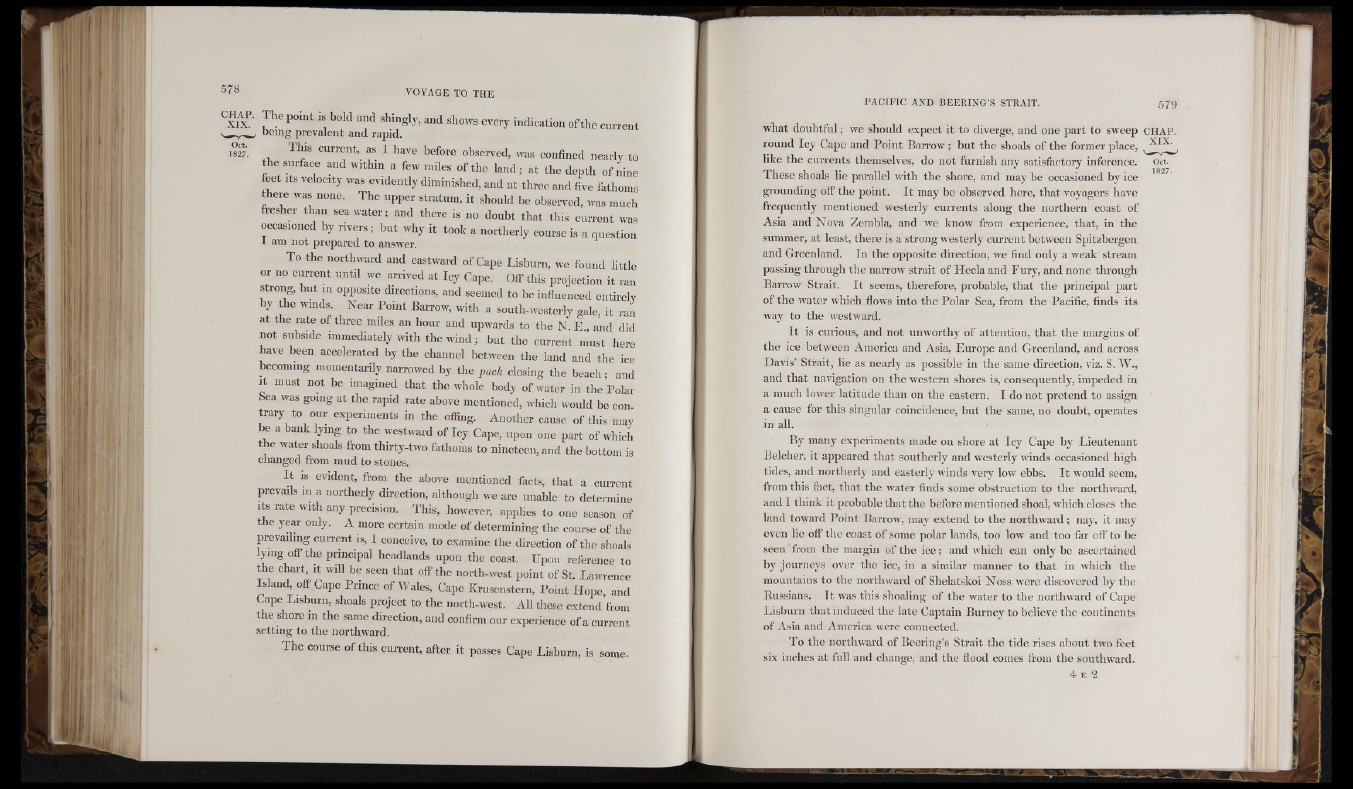
'If
J'
ri "
11-1
I'to
r i r
i( «1
'!"':
T.....
f 'I!tii til: III
T i l l ' T'le point IS bold and sbingly, and shows every indication ofthe current
being prevalent and rapid.
0«; This current, as 1 have before observed, was confined nearly to
the surface and w.thm a few miles o fth e land; at the depth of nine
feet Its velocity was evidently diminished, and at three and five fathoms
there was none. The upper stratum, it should be observed, wns much
fresher than sea water; and there is no doubt that this current was
occasioned by rivers; but why it took a northerly course is a question
1 am not prepared to answer.
To the northivard and eastivard of Cape Lisburn, we found little
or no current until we arrived at Icy Cape. Off this projection it ran
strong, but in opposite directions, and seemed to be influenced entirely
by the winds. Near Point Barrow, with a south-westerly gale, it ran
at the rate of three miles an hour and upwards to the N. E., and did
not subside immediately with the wind ; but the current must here
have been accelerated by the channel between the land and the ice
becoming momentarily narrowed by the pack closing the beach- and
It must not be imagined that the whole body of water in the Polar
bea was going at the rapid rate above mentioned, ivhich would be con
trary to our experiments in the offing. Another cause of this may
be a bank lying to the westward of Icy Cape, upon one part of ivhich
the water shoals from thirty-two fathoms to nineteen, and the bottom is
changed from mud to stones.
It IS evident, from the above mentioned facts, that a current
prevails in a northerly direction, although we are unable to determine
Its rate with any precision. This, however, applies to one season of
the year only. A more certain mode of determining the course of the
prevailing current is, I conceive, to examine the direction ofth e shoals
lying offthe principal headlands upon the coast. Upon reference to
the chart, it will be seen that offthe north-west point of St. Lawrence
Island, off Cape Prince of AVales, Cape Krusenstern, Point Hope, and
Cape Lisburn, shoals project to the north-west. All these extend’from
the shore in the same direction, and confirm our experience of a current
setting to the northward.
The course of this current, after it passes Cape Lisburn, is some-
what doubtful; we should expect it to diverge, and one part to sweep CHAP.
round Icy Cape and Point Barrow; but the shoals of the former place,
like the currents themselves, do not furnish any satisfactory inference.
Oct.
These shoals lie parallel with the shore, and may be occasioned by ice
1827.
grounding off the point. It may be observed here, that voyagers have
frequently mentioned westerly currents along the northern coast of
Asia and Nova Zembla, and we know from experience, that, in the
summer, at least, there is a strong westerly current between Spitzbergen
and Greenland. In the opposite direction, we find only a weak stream
passing through the narrow strait of Hecla and Fury, and none through
Barrow Strait. It seems, therefore, probable, that the principal part
of the water which flows into the Polar Sea, from the Pacific, finds its
way to the westward.
It is curious, and not unworthy of attention, that the margins of
the ice between America and Asia, Europe and Greenland, and across
Davis’ Strait, lie as nearly as possible in the same direction, viz. S. 7V.,
and that navigation on the western shores is, consequently, impeded in
a much lower latitude than on the eastern. I do not pretend to assign
a cause for this singular coincidence, but the same, no doubt, operates
in all.
By many experiments made on shore at Icy Cape by Lieutenant
Belcher, it appeared that southerly and westerly winds occasioned high
tides, and northerly and easterly winds very low ebbs. It would seem,
from this fact, that the water finds some obstruction to the northward,
and I think it probable that the before mentioned shoal, which closes the
land toward Point Barrow, may extend to the northward; nay, it may
even lie off the coast of some polar lands, too low and too far ofi* to be
seen from the margin of the ic e ; and which can only be ascertained
by journeys over the ice, in a similar manner to that in which the
mountains to the northward of Shelatskoi Noss were discovered by the
Kussians. It was this shoaling of the water to the northward of Cape
Lisburn that induced the late Captain Burney to believe the continents
of Asia and America were connected.
To the northward of Beering’s Strait the tide rises about two feet
six inches at full and change, and the flood comes from the southward.
4 E 2